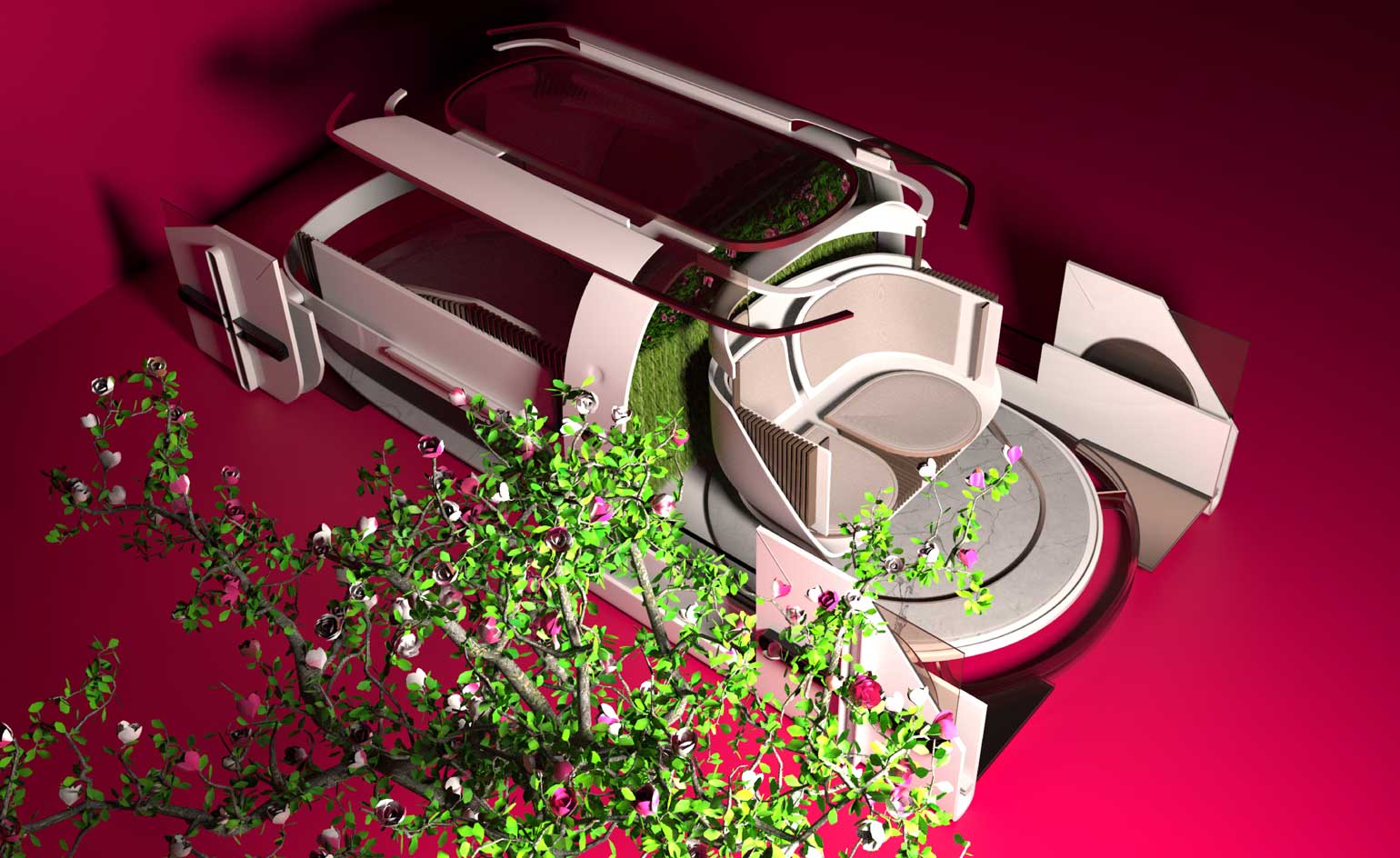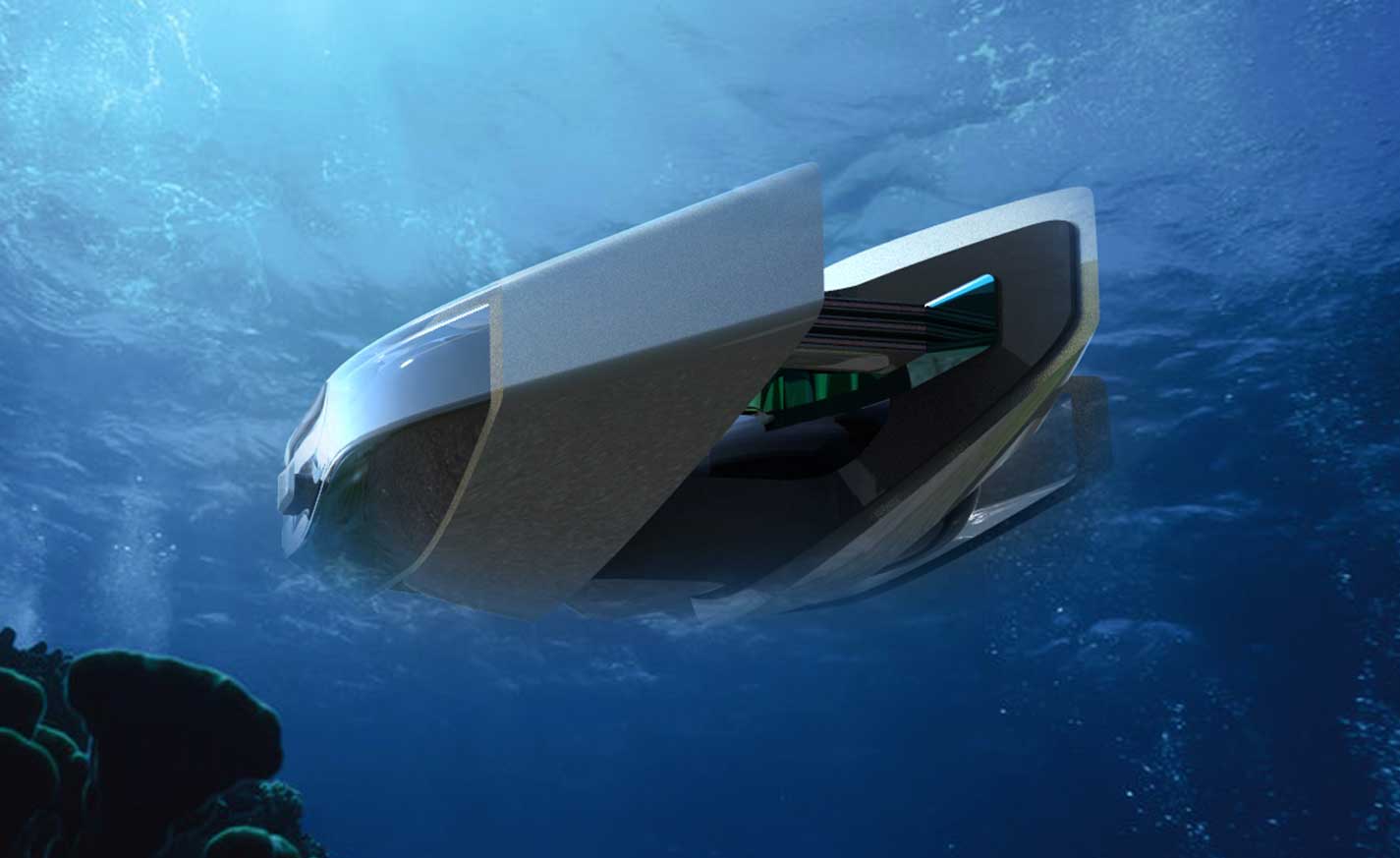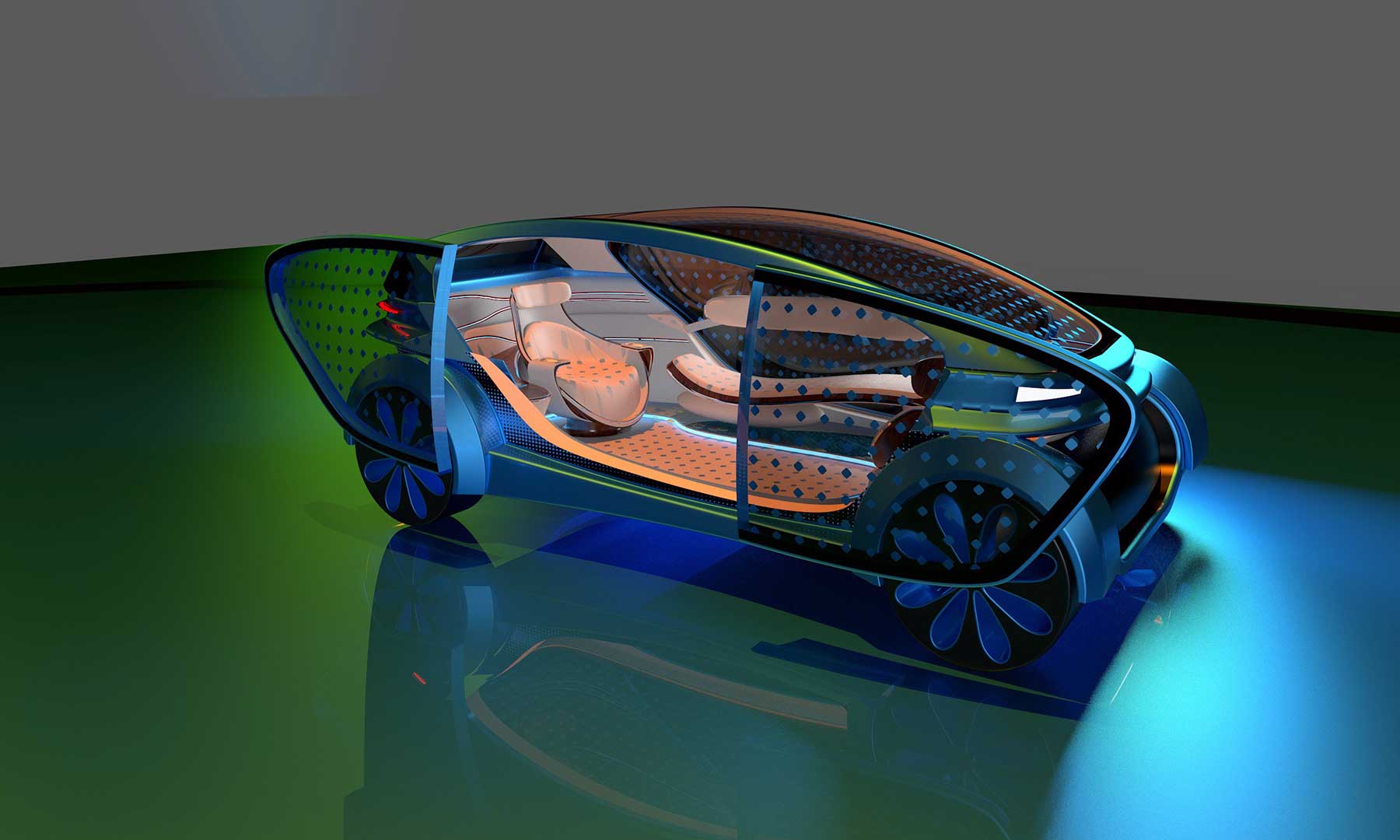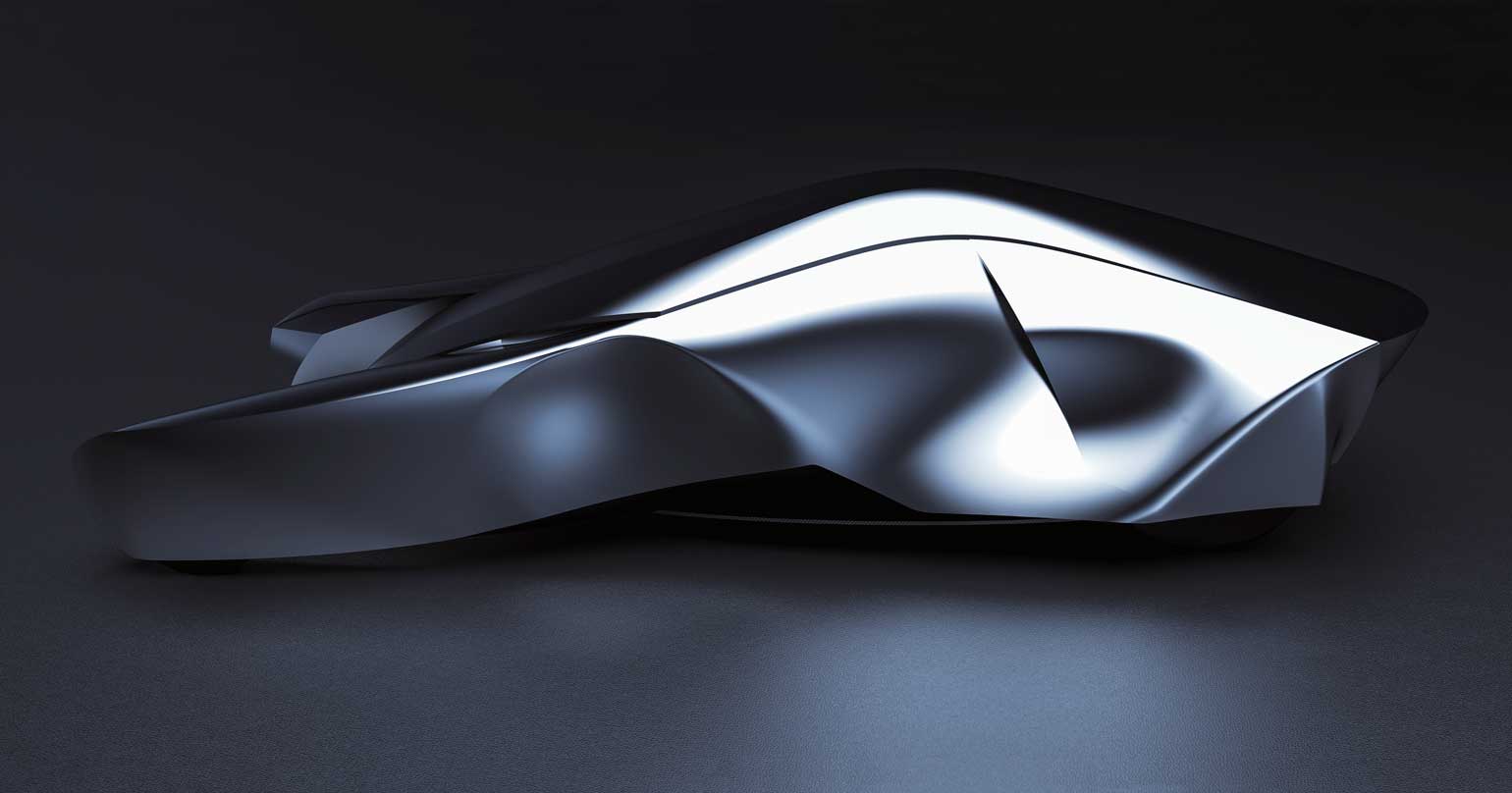
The graduates of The Royal College of Art’s inaugural Intelligent Mobility degree course unveiled the fruits of their labours last month. The London-based Master of Arts course attracts designers from across the globe and was renamed from Vehicle Design in 2018 to reflect a world increasingly requiring vehicles to connect, share, electrify and become autonomous.
Unsurprisingly the results are much wider in scope than in previous years. ‘The cars this year are different,’ says Chris Thorpe, acting head of the Intelligent Mobility programme. ‘We had 34 graduates and only 10-15 per cent created four-wheeled vehicles. We’re getting a lot of students from undergraduate courses in product and interior design and applying that thinking to a vehicle context, especially in user experience. It’s still about the emotional response of looking at a well-designed vehicle, but in addition it’s also the experience inside the vehicle during the journey – which is increasingly becoming more complex – as we move towards the concept of autonomous vehicles.’ From underwater vehicles to ‘flying cars’, and wearable mobility to floating houses, here are the 2019 RCA Intelligent Mobility graduate concepts that really drive it home.
A shared car for those who don’t want to share, by Aditya Jangid, India
This concept (pictured top) did have four wheels – carefully hidden within its side walls and marked with a graphic cross – but Aditya Jangid’s Shared car for those who don’t want to share looked more like a beautifully-designed lounge than a conventional car. Pitched as a city solution in a future where Transport for London has banned all minimum-occupancy cars from its central zone, the vehicle can be partially or fully-shared, depending on the various users’ required level of privacy, through a movable plant-covered wall which can slide back and forth to divide, while semi-circular seating rotates 180 degrees to open up the cabin space. The design is appealing both in concept and aesthetic – but why the plant wall? ‘The wall not only helps maintain privacy between spaces but also hygiene inside the vehicle,’ says Jangid, before adding: ‘It’s a natural touch to a rather mechanical car and soothes the users, like sitting in a garden.’
Ocean Community, by Wojciech Morsztyn, Poland

With climate change predicted to bring life-changing rises in sea levels in many low-lying global coastal regions, RCA Intelligent Mobility graduate Wojciech Morsztyn envisions a solution via inter-linked floating living spaces which could perhaps inhabit flooded areas near to the new land’s edge. Connected to each other by walkways and to the land by shuttles, the pods are designed to create privacy, store and filter water, channel airflow for cooling and harvest energy from the sun and wind. Morsztyn's pods look expensive, but he explains that he has investigated the costings and says they could be as low as £150,000 per unit based on technology that would be mature by his concept’s intended implementation date of 2035. He also says the pods could present a great opportunity to be located outside of overcrowded cities.
Range Rover Endeavour, by Rhys Llewellyn, England (with Welsh roots)

‘Above and Beyond’ has been a tagline of off-road brand experts Range Rover for some time, but to our knowledge it’s not been applied to underwater activities thus far. This is where Rhys Llewellyn’s Endeavour concept comes in, envisioning an adaptable triple-vehicle system that ocean explorers could utilise ‘Below and beyond’ but without adversely affecting the watery ecosystems being investigated. Llewellyn designed two modules that can descend to a depth of 3,000 ft and feature an interchangeable module that can, depending on requirements, be a passenger compartment, contain water desalination manufacturing elements or generate power (via wave energy). As Llewellyn reasons: ‘Why dig trenches and install pipework when the water, energy and waste can be managed in a more dynamic, less intrusive way?’ The third ‘command vessel’ stays just below the water, as the concept’s eye in the sky, monitoring weather, safety and ocean currents to make sure all craft are protected.
The Sanctuary, by Nowroze Ghaffar, India

The idea of a luxury lounge on wheels is a common theme among future autonomous vehicle concepts. Nowroze Ghaffar’s The Sanctuary follows in those broad tyre tracks but with an emphasis on a calming space to reduce anxiety. His project displayed a remarkable amount of effort, assuring that experience came alive, even down to having his concept seat design manufactured in full scale in China and then inviting visitors to sit in it, don virtual reality goggles and explore his proposed car cabin.
Shared Identity for Shared Mobility, by Jiayue Wu, China
Another lounge on wheels – but an excellent example with a distinctly Chinese aesthetic – Jiayue Wu’s concept for the city of Suzhou in south-east China is designed around the idea of ‘building the identity of mobility based on the identity of city: to create a city icon rooted in its own culture which can blend into the urban landscape, provide public space for urban lives, leave strong impressions on tourists and create a sense of belonging and pride for the citizens.’ The minimalist design of simple vertical and horizontal lines features dark natural wood, an on-board tree and bookcase to create a civilised cabin atmosphere, plus collapsible seating to pull out of the car and use in public spaces when parked. As envisioned, it looks like it would fit right in.
Project Antelope & Scout, by Kun-Yang Chen & Kai-Tse Lin, Taiwan

With some 130 ‘flying vehicle’ projects currently under development around the world with big names like Airbus, Rolls-Royce and Uber investing, Kun-Yang Chen & Kai-Tse Lin’s Project Antelope concept is far less pie-in-sky than might have been the case if proposed in the decades previous. Fresh from creating a hovercraft for his BA in Taiwan, Kun-Yang Chen designed a one-seat, carbon fibre, multi-rotor flying vehicle for his RCA MA project, with the idea of enclosing all the working parts to create a greater ‘sense of safety’. Meanwhile, Kai-Tse Lin’s role focused on the user experience and also planning the urban transport system this ‘flying vehicle’ would inhabit. Dubbed Project Scout, ‘it’s about finding new ways of living through creating a second city surface,’ he explains. The pair have already formed a company ambitiously called Bellwether Industry and have a partner in Dubai helping with development costs. Entrepreneurial.
Project Icarus, by Pengduowen Li, China
Receive our daily digest of inspiration, escapism and design stories from around the world direct to your inbox.

Majoring on the car as experimental sculpture, Pengduowen Li’s striking exterior comprising cuts and creases was inspired by ‘disruptive architectural design’ – Frank Gehry perhaps? – and how exterior car design aesthetics will be affected by the forthcoming era of autonomy. In such a vehicle, conventional glazing won’t be so relevant, as there’s no driver requirement to see out in the same way, so the vehicle’s bodywork can surround the occupants in new ways.
Wearable mobility, by Chenchang (Astra) Li, China
‘What would it be like when a car can be worn on the body as a cloth?’ asks Chinese RAC graduate Chenchang (Astra) Li. His resulting answer is an interesting functional fusion of a mobility system and clothing, where the user leans forward into the three-wheeled vehicle while being enveloped by its protective arms and back covering.
INFORMATION
For more information, visit the Royal College of Art website
Guy Bird is a London-based writer, editor and consultant specialising in cars and car design, but also covers aviation, architecture, street art, sneakers and music. His journalistic experience spans more than 25 years in the UK and global industry. See more at www.guybird.com
-
 Year in review: the shape of mobility to come in our list of the top 10 concept cars of 2025
Year in review: the shape of mobility to come in our list of the top 10 concept cars of 2025Concept cars remain hugely popular ways to stoke interest in innovation and future forms. Here are our ten best conceptual visions from 2025
-
 These Guadalajara architects mix modernism with traditional local materials and craft
These Guadalajara architects mix modernism with traditional local materials and craftGuadalajara architects Laura Barba and Luis Aurelio of Barbapiña Arquitectos design drawing on the past to imagine the future
-
 Robert Therrien's largest-ever museum show in Los Angeles is enduringly appealing
Robert Therrien's largest-ever museum show in Los Angeles is enduringly appealing'This is a Story' at The Broad unites 120 of Robert Therrien's sculptures, paintings and works on paper
